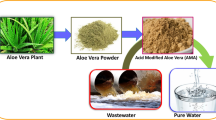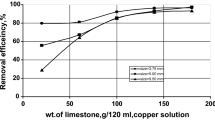Abstract
This study investigates the process conditions of the adsorption of copper (II) ion onto paper mill sludge (PMS) in a batch process. These conditions are: concentration of initial solution, contact time, temperature and quantity of the adsorbent. Characteristic properties of PMS employed as an adsorbent in the experiments were defined using Fourier transform infrared spectroscopy (FT-IR) scanning electron microscopy (SEM) and elemental analyses. According to the obtained results, while the amount of removed copper (II) ion increased with an increase in the rate of the adsorbent and contact time, it decreased as a result of an increase in the temperature and initial solution concentration. Langmuir, Freundlich and Dubinin-Radushkevich (D-R) isotherms were implemented for the determination of the most appropriate isotherm model for the experimental data, and it was found that the process is in concordance with Langmuir equation. The maximum adsorption capacity of PMS was calculated as 114.42 mg g\(^{-1}\). In kinetic studies, the adsorption process of copper (II) ion onto PMS was controlled by the pseudo-second-order kinetic model. The calculated activation value (\(E_{\mathrm{a}})\) was 38.61 kJ mol\(^{-1}\) and demonstrates that the process occurred by physical adsorption mechanism. The values of the thermodynamic parameters such as enthalpy (\(\Delta {H}^{{{ O}}})\,(-21.19\,\hbox {kJ\,mol}^{-1})\), free energy (\(\Delta {G}^{\mathrm{O}}\)) (−8.883 kJ mol\(^{-1}\)) and entropy (\(\Delta {S}^{\mathrm{O}})\) (0.101 kJ mol\(^{-1}\) K\(^{-1}\)) changes were determined to estimate the nature of the process. The results clearly showed that the process was of exothermic and spontaneous nature and that PMS could be utilized as an adsorbent for the removal of copper (II) ion from wastewater.
Similar content being viewed by others
Abbreviations
- \(C_{\mathrm{o}}\) :
-
Initial concentration of Cu (II) solution (mM)
- \(C_{\mathrm{s}}\) :
-
Final concentration of Cu (II) solution (mM)
- \(C_{\mathrm{e}}\) :
-
Cu (II) concentration in solution at equilibrium (mM L\(^{-1})\)
- \(q_{\mathrm{e}}\) :
-
Amount of Cu (II) ions adsorbed per unit mass of adsorbent (mM g\(^{-1}\))
- \(q_{\max }\) :
-
Maximum adsorption capacity (mM g\(^{-1})\)
- v :
-
Volume of the solution (L)
- m :
-
Amount of adsorbent (g)
- \(q_{\mathrm{e}}\) :
-
Amount of Cu (II) ions adsorbed at equilibrium (mM g\(^{-1}\))
- \(q_{\mathrm{t}}\) :
-
Amount of Cu (II) ions adsorbed at time t (mM g\(^{-1}\))
- \(k_{1}\) :
-
Pseudo-first-order reaction rate constant (min\(^{-1})\)
- \(k_{2}\) :
-
Pseudo-second-order reaction rate constant (g mM\(^{-1}\) min\(^{-1})\)
- \(k_{i}\) :
-
Intra-particle diffusion rate constant (mM g\(^{-1}\) min\(^{-1/2})\)
- b :
-
Adsorption energy (L mM\(^{-1})\)
- \(K_{\mathrm{f}}\) :
-
Adsorption capacity (mg g\(^{-1})\)
- n :
-
Adsorption intensity
- \(q_{\mathrm{m}}\) :
-
Maximum amount of Cu (II) ion adsorbed onto unit weight of adsorbent (mg g\(^{-1})\)
- \(\beta \) :
-
Adsorption energy (mol\(^{2}\) kJ\(^{-2})\)
- \(\varepsilon \) :
-
Polanyi potential
- R :
-
Universal gas constant (kJ mol\(^{-1}\) K\(^{-1})\)
- T :
-
Temperature (K)
- r :
-
Separation factor
- b :
-
Langmuir constant (L mM\(^{-1})\)
- m / V :
-
Adsorbent/solution ratio (g L\(^{-1})\)
- \(b_{\mathrm{o}}\) :
-
A constant
- \(\Delta H^{\mathrm{o}}\) :
-
Enthalpy (kJ mol\(^{-1}\))
- \(\Delta S^{\mathrm{o}}\) :
-
Entropy (kJ mol\(^{-1}\) K\(^{-1}\))
- \(\Delta G^{\mathrm{o}}\) :
-
Gibbs free energy (kJ mol\(^{-1}\))
References
Ong, S.-A.; et al.: Comparative study on kinetic adsorption of Cu (II), Cd (II) and Ni (II) ions from aqueous solutions using activated sludge and dried sludge. Appl. Water Sci. 3(1), 321–325 (2013)
Soetaredjo, F.E.; et al.: Incorporation of selectivity factor in modeling binary component adsorption isotherms for heavy metals-biomass system. Chem. Eng. J. 219, 137–148 (2013)
Şengil, İ.A.; Özacar, M.; Türkmenler, H.: Kinetic and isotherm studies of Cu (II) biosorption onto valonia tannin resin. J. Hazard. Mater. 162(2), 1046–1052 (2009)
Liu, Y.; Sun, X.; Li, B.: Adsorption of Hg 2+ and Cd 2+ by ethylenediamine modified peanut shells. Carbohydr. Polym. 81(2), 335–339 (2010)
Zhu, B.; Fan, T.; Zhang, D.: Adsorption of copper ions from aqueous solution by citric acid modified soybean straw. J. Hazard. Mater. 153(1), 300–308 (2008)
Abdel-Aziz, M.H.; Nirdosh, I.; Sedahmed, G.H.: Ion-exchange-assisted electrochemical removal of heavy metals from dilute solutions in a stirred-tank electrochemical reactor: a mass-transfer study. Ind. Eng. Chem. Res. 52(33), 11655–11662 (2013)
Rivas, B.L.; Palencia, M.: Removal-concentration of pollutant metal-ions by water-soluble polymers in conjunction with double emulsion systems: a new hybrid method of membrane-based separation. Sep. Purif. Technol. 81(3), 435–443 (2011)
Lovell, A.; et al.: Biosorption and chemical precipitation of lead using biomaterials, molecular sieves, and chlorides, carbonates, and sulfates of Na & Ca. J. Environ. Protect. 4(11):1251 (2013)
Vasudevan, S.; Lakshmi, J.: Process conditions and kinetics for the removal of copper from water by electrocoagulation. Environ. Eng. Sci. 29(7), 563–572 (2012)
Vasudevan, S.; et al.: A critical study on the removal of copper by an electrochemically assisted coagulation: equilibrium, kinetics, and thermodynamics. Asia-Pac. J. Chem. Eng. 8(1), 162–171 (2013)
Vasudevan, S.; Lakshmi, J.; Sozhan, G.: Electrocoagulation studies on the removal of copper from water using mild steel electrode. Water Environ. Res. 84(3), 209–219 (2012)
Singha, B.; Das, S.K.: Adsorptive removal of Cu (II) from aqueous solution and industrial effluent using natural/agricultural wastes. Colloids Surf. B 107, 97–106 (2013)
Vasudevan, S.; Lakshmi, J.: The adsorption of phosphate by graphene from aqueous solution. Rsc Adv. 2(12), 5234–5242 (2012)
Yargıç, A.; et al.: Assessment of toxic copper (II) biosorption from aqueous solution by chemically-treated tomato waste. J. Clean. Prod. 88, 152–159 (2015)
Taşar, Ş.; Kaya, F.; Özer, A.: Biosorption of lead (II) ions from aqueous solution by peanut shells: equilibrium, thermodynamic and kinetic studies. J. Environ. Chem. Eng. 2(2), 1018–1026 (2014)
Monte, M.C.; et al.: Waste management from pulp and paper production in the European Union. Waste Manage. (Oxford) 29(1), 293–308 (2009)
Ahmaruzzaman, M.: Industrial wastes as low-cost potential adsorbents for the treatment of wastewater laden with heavy metals. Adv. Colloid Interface Sci. 166(1), 36–59 (2011)
Garcia Alba, L.; et al.: Hydrothermal treatment (HTT) of microalgae: evaluation of the process as conversion method in an algae biorefinery concept. Energy Fuels 26(1), 642–657 (2011)
Gavrilescu, D.: Energy from biomass in pulp and paper mills. Environ. Eng. Manag. J. 7(5), 537–546 (2008)
He, X.; et al.: Paper sludge as a feasible soil amendment for the immobilization of Pb 2+. J. Environ. Sci. 22(3), 413–420 (2010)
Bajpai, P.: Management of Pulp and Paper Mill Waste. Springer, Berlin (2015)
Largergren, S.: Zur theorie der sogenannten adsorption geloster stoffe. Kungliga Svenska Vetenskapsakademiens. Handlingar 24, 1–39 (1898)
Ho, Y.; et al.: Study of the sorption of divalent metal ions on to peat. Adsorpt. Sci. Technol. 18(7), 639–650 (2000)
Weber, W.J.; Morris, J.C.: Kinetics of adsorption on carbon from solution. J. Sanit. Eng. Div. 89(2), 31–60 (1963)
Langmuir, I.: The adsorption of gases on plane surfaces of glass, mica and platinum. J. Am. Chem. Soc. 40(9), 1361–1403 (1918)
Freundlich, H.: Over the adsorption in solution. J. Phys. Chem. 57(385471), 1100–1107 (1906)
Dubinin, M.: Porous structure and adsorption properties of active carbons. Chem. Phys. Carbon 2, 51–120 (1966)
Arslanoglu, H.; Altundogan, H.S.; Tumen, F.: Heavy metals binding properties of esterified lemon. J. Hazard. Mater. 164(2), 1406–1413 (2009)
Torab-Mostaedi, M.; et al.: Removal of cadmium and nickel from aqueous solution using expanded perlite. Braz. J. Chem. Eng. 27(2), 299–308 (2010)
Mohamad, S.; et al.: Removal of phosphate by paper mill sludge: adsorption isotherm and kinetic study. Asian J. Chem. 26(12), 3545 (2014)
Aksu, Z.; İşoğlu, İ.A.: Removal of copper (II) ions from aqueous solution by biosorption onto agricultural waste sugar beet pulp. Process Biochem. 40(9), 3031–3044 (2005)
Weng, C.-H.; et al.: Effective removal of copper ions from aqueous solution using base treated black tea waste. Ecol. Eng. 67, 127–133 (2014)
Ganesan, P.; Kamaraj, R.; Vasudevan, S.: Application of isotherm, kinetic and thermodynamic models for the adsorption of nitrate ions on graphene from aqueous solution. J. Taiwan Inst. Chem. Eng. 44(5), 808–814 (2013)
Yao, Z.-Y.; Qi, J.-H.; Wang, L.-H.: Equilibrium, kinetic and thermodynamic studies on the biosorption of Cu (II) onto chestnut shell. J. Hazard. Mater. 174(1), 137–143 (2010)
Vasudevan, S.; Lakshmi, J.; Packiyam, M.: Electrocoagulation studies on removal of cadmium using magnesium electrode. J. Appl. Electrochem. 40(11), 2023–2032 (2010)
Kamaraj, R.; et al.: Eco-friendly and easily prepared graphenenanosheets for safe drinking water: removal of chlorophenoxyacetic acid herbicides. ChemistrySelect 2(1), 342–355 (2017)
Ansari, T.M.; et al.: Reclamation of wastewater containing Cu (II) using alginated Mentha spicata biomass. Desalin. Water Treat. 57(23), 10700–10709 (2016)
Ali, R.M.; et al.: Potential of using green adsorbent of heavy metal removal from aqueous solutions: adsorption kinetics, isotherm, thermodynamic, mechanism and economic analysis. Ecol. Eng. 91, 317–332 (2016)
Yao, Z.-Y.; et al.: Insolubilization of chestnut shell pigment for Cu (II) adsorption from water. Molecules 21(4), 405 (2016)
Zheng, J.-C.; et al.: Removal of Cu (II) in aqueous media by biosorption using water hyacinth roots as a biosorbent material. J. Hazard. Mater. 171(1), 780–785 (2009)
Dahiya, S.; Tripathi, R.; Hegde, A.: Biosorption of heavy metals and radionuclide from aqueous solutions by pre-treated arca shell biomass. J. Hazard. Mater. 150(2), 376–386 (2008)
Rafatullah, M.; et al.: Adsorption of copper (II), chromium (III), nickel (II) and lead (II) ions from aqueous solutions by meranti sawdust. J. Hazard. Mater. 170(2), 969–977 (2009)
Guechi, E.-K.; Hamdaoui, O.: Evaluation of potato peel as a novel adsorbent for the removal of Cu (II) from aqueous solutions: equilibrium, kinetic, and thermodynamic studies. Desalin. Water Treat. 57(23), 10677–10688 (2016)
Janyasuthiwong, S.; et al.: Copper, lead and zinc removal from metal-contaminated wastewater by adsorption onto agricultural wastes. Environ. Technol. 36(24), 3071–3083 (2015)
Author information
Authors and Affiliations
Corresponding author
Rights and permissions
About this article
Cite this article
Yaras, A., Arslanoğlu, H. Valorization of Paper Mill Sludge as Adsorbent in Adsorption Process of Copper (II) Ion from Synthetic Solution: Kinetic, Isotherm and Thermodynamic Studies. Arab J Sci Eng 43, 2393–2402 (2018). https://doi.org/10.1007/s13369-017-2817-3
Received:
Accepted:
Published:
Issue Date:
DOI: https://doi.org/10.1007/s13369-017-2817-3




